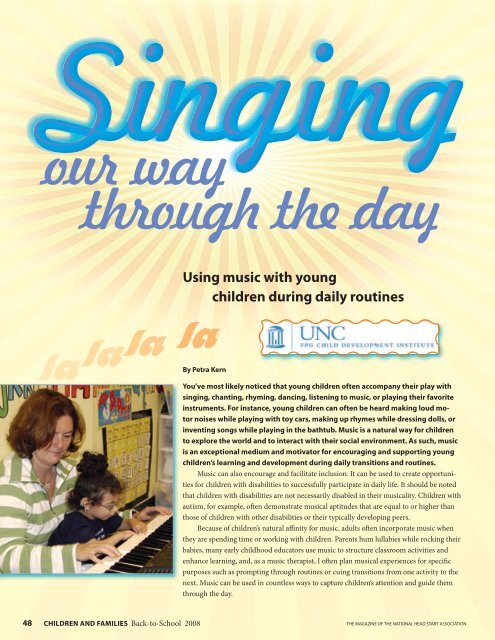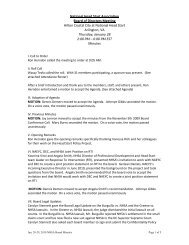New! - National Head Start Association
New! - National Head Start Association
New! - National Head Start Association
Create successful ePaper yourself
Turn your PDF publications into a flip-book with our unique Google optimized e-Paper software.
our way<br />
through the day<br />
48 THE MAGAZINE OF THE NATIONAL HEAD START ASSOCIATION<br />
CHILDREN AND FAMILIES Back-to-School 2008<br />
Using music with young<br />
children during daily routines<br />
By Petra Kern<br />
You’ve most likely noticed that young children often accompany their play with<br />
singing, chanting, rhyming, dancing, listening to music, or playing their favorite<br />
instruments. For instance, young children can often be heard making loud motor<br />
noises while playing with toy cars, making up rhymes while dressing dolls, or<br />
inventing songs while playing in the bathtub. Music is a natural way for children<br />
to explore the world and to interact with their social environment. As such, music<br />
is an exceptional medium and motivator for encouraging and supporting young<br />
children’s learning and development during daily transitions and routines.<br />
Music can also encourage and facilitate inclusion. It can be used to create opportunities<br />
for children with disabilities to successfully participate in daily life. It should be noted<br />
that children with disabilities are not necessarily disabled in their musicality. Children with<br />
autism, for example, o en demonstrate musical aptitudes that are equal to or higher than<br />
those of children with other disabilities or their typically developing peers.<br />
Because of children’s natural a nity for music, adults o en incorporate music when<br />
they are spending time or working with children. Parents hum lullabies while rocking their<br />
babies, many early childhood educators use music to structure classroom activities and<br />
enhance learning, and, as a music therapist, I o en plan musical experiences for speci c<br />
purposes such as prompting through routines or cuing transitions from one activity to the<br />
next. Music can be used in countless ways to capture children’s attention and guide them<br />
through the day.




